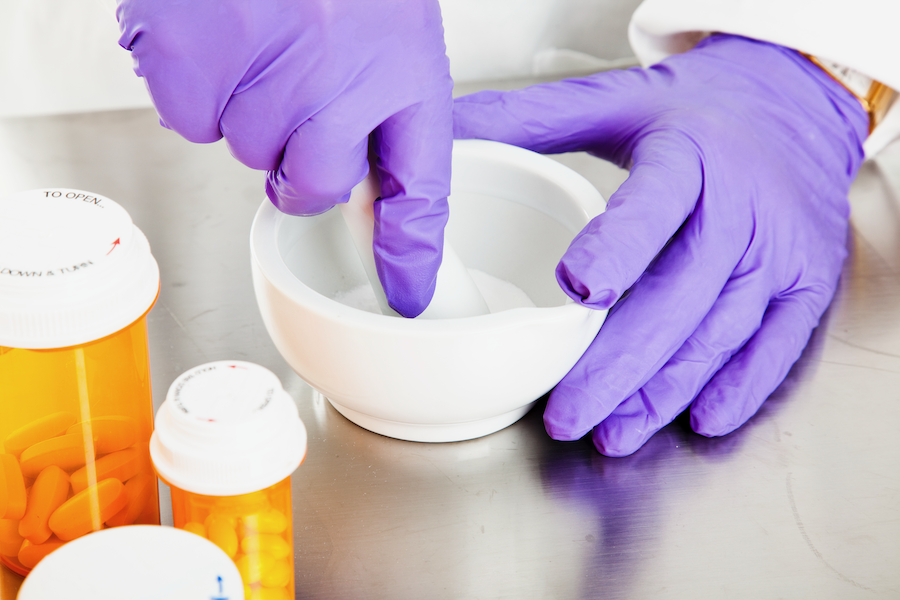Dietitian Blog, Long-Term Care, MNT Guidelines, Nutrition Support | Apr 19 2022
Down the tube: Balancing enteral nutrition and medications

We’ve all been there… A nurse informs you that a patient’s feeding tube has clogged after administering several medications. A pharmacist notifies you that the enteral nutrition (EN) infusion needs to be held for antibiotic administration. A physician asks you if the EN regimen will decrease efficacy of a drug. Interactions between medications and components of an EN regimen do occur and may adversely affect patient outcomes. Managing these interactions often takes a multidisciplinary approach, and dietitians play a key role in helping to mitigate these issues. Here’s what you need to know to help your medical team.
Does tube type matter?1
In brief, there is no preferred type of feeding tube that allows for optimal medication delivery. In fact, interactions between medications and EN are best mitigated if the medication is given via a route other than the feeding tube, usually by mouth or intravenously. Your pharmacist will adjust medications as appropriate. Usually there are a few medications that cannot be converted to another form, so components of both the medications as well as the EN regimen should be considered.
Medication considerations1
Liquid versions of drugs are often preferred by nurses to allow easy administration via tubing. Some medication dosages do not have an equivalent liquid form and cannot be adjusted. In these cases, a tablet or capsule is prescribed.
Tablets can be crushed and dissolved into a liquid for administration via the tube. Capsules can be opened, and the powder or finely crushed solids can be mixed with water to form a slurry before administration. If this approach is taken, the pharmacist must ensure this won’t adversely alter the drug. Some medication dosages are designed for specific applications, and these should be considered when deciding how to administer them. For example:
- Enteric coated drugs are designed to protect the active ingredients from gastric acid or protect the stomach from irritation. Generally, these should not be crushed. This can cause destruction of the active form or contribute to gastric irritation. Jejunal administration is allowed if the drug is dissolved in a bicarbonate solution and crushed. This process can be slow, and tube patency should be monitored.
- Long-acting or extended release drugs are intended to reduce the number of daily doses. Crushing these forms should also be avoided, as it may cause immediate release of the total drug dose.
- Film coated drugs are utilized to mask the taste of a drug for patient comfort. Crushing a film coated tablet should not adversely alter the drug content. However, the film may remain undissolved and sticky and contribute to tube occlusion, so caution should be exercised.
Consult with manufacturer guidelines or your pharmacist to ensure proper administration. Many hospitals, as well as the Institute for Safe Medication Practices, provide a reference list of medications that should not be crushed.
Medications of concern1,2
Certain medications have demonstrated decreased efficacy when administered via enteral route. To avoid this, the following practices should be considered:
- Consider holding EN infusion for one to two hours before and after administration of phenytoin.
- Fluoroquinolones such as ciprofloxacin and levofloxacin may be better absorbed if separated from enteral feedings for at least two hours.
- Hold EN for one hour before and after administration of levothyroxine.
- Carbamazepine should be adequately absorbed via gastric access. If administering this medication via a post-pyloric route and unable to achieve therapeutic drug results, it may be reasonable to hold EN for two hours before and after administration.
- Warfarin should be closely monitored to ensure therapeutic levels are achieved. Routine holding of EN is usually not necessary. First line of defense should be to minimize the contact time with EN tubing by rapidly administering a concentrated form. If results are not achieved, holding EN infusion around administration can be considered.
- Dolutegravir should be separated from enteral feeding for two hours before and after drug administration.
- Levodopa should be avoided with large protein doses, and therefore should be separated from intermittent feeds or protein administration by two hours.
The mechanism of interaction between EN and medications is not always clearly defined and definitive guidelines are lacking on some drug classes. Therefore, practice differs between facilities. Chat with your pharmacist about best practice guidelines at your facility.
Clogged tubes – The creaded cilemma1,3
Tube occlusion is more likely to occur with concentrated enteral formulas, use of fiber supplements, frequent checking of gastric residual volumes, and improper medication delivery. When this happens, it’s important to troubleshoot with your nurse and healthcare team to ensure the clogged tube is cleared and EN administration can resume quickly. To troubleshoot, consider the following:
- Ensure that EN infusion is being paused for medication delivery.
- Check that a minimum of 30 mL of water is administered before and after medications. More volume may be needed to fully clear larger or longer tubes.
- If multiple drugs are given, ask if flushes are occurring between drugs.
- Ensure medications are being properly crushed, mixed, or dissolved prior to administration via feeding tube.
- Try flushing the tube with warm water. If needed, allow the water to dwell in the tube. If unable to clear occlusion, consider flushing with pancreatic enzymes or using a commercial declogging kit or stylet.
- If unable to unclog the tube, consider replacing it.
Dietitians On Demand is a nationwide staffing and recruiting company for registered dietitians, specializing in short-term, temporary and permanent-hire positions in acute care, long term care and food service positions. We’re dedicated to dietitians and helping them enhance their practice and excel in the workplace. Check out our job openings, request your coverage, or visit our store today!
References
-
Verdell, A. and Rollins, C., 2017. Chapter 18 Drug Nutrient Interactions. In: ASPEN Adult Nutrition Support Core Curriculum, 3rd ed. pp.361-377.
-
Boullata, J., 2020. Enteral Medication for the Tube‐Fed Patient: Making This Route Safe and Effective. Nutrition in Clinical Practice, 36(1), pp.111-132.
-
Garrison, C., 2018. Enteral Feeding Tube Clogging: What Are the Causes and What Are the Answers? A Bench Top Analysis. Nutrition in Clinical Practice, 33(1), pp.147-150.
Who we are
Dietitians On Demand is the nationwide leader in providing dietitians with jobs they love. If flexibility, competitive pay, a full benefits package, free CPEUs each month and a team dedicated to dietitians sound good to you, apply to our positions today.




